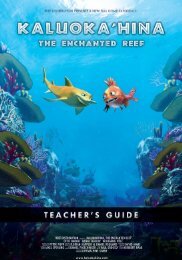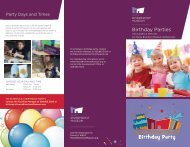EARTH, MOON & SUN - Peoria Riverfront Museum
EARTH, MOON & SUN - Peoria Riverfront Museum
EARTH, MOON & SUN - Peoria Riverfront Museum
You also want an ePaper? Increase the reach of your titles
YUMPU automatically turns print PDFs into web optimized ePapers that Google loves.
<strong>EARTH</strong>, <strong>MOON</strong> & <strong>SUN</strong>LESSON PLANNINGThis guide describes a variety of activitiesthat build on content referred to inthe Earth, Moon & Sun show. Becausewriting is such an important skill to developthroughout a child’s school years, many of theactivities emphasize language arts. Science,social studies, and information skills are alsoaddressed. The activities in this guide can beconducted during class periods after studentssee Earth, Moon & Sun. Some of the activitiescan also be used to help to prepare students forthe experience of seeing the show. (Trainingand materials for additional activities—includingmany connected to Earth, Moon & Sun’sastronomy and math content—are included inthe Morehead’s A Peak at PLANETS teacherworkshops.)The following sample lesson plan uses activitiesselected from the Earth, Moon & Sunclassroom activities guide:TEACHER’S GUIDE: BEFORE THE SHOWPart 1. Review “Information for Teachers:About Coyotes” (pp. 21-22) and “Write fromYour Research: Prompt A” (p. 13). Let studentsknow that a coyote plays an important part inthe planetarium show they will be seeing. Tootes.Ask students to (individually or in groups)prepare short factual reports on coyotes. In a may already know about coyotes. Follow witha web quest or research in books from theschool’s media center. Students can draw picturesto accompany their writing.Part 2. Review “Information for Teachers:About the Sun” (pp. 23-24) and “Coyote andSun: Learning about Food Chains” (pp. 10-11). Using their research about coyotes, studentscan create food chains in which coyotesare links. They can also create paper-bag puppetsof the Sun, Coyote, and other organismsin their food chains and present simple skitsillustrating the transfer of energy within theirchosen ecosystems.TEACHER’S GUIDE: AFTER THE SHOWPart 1. Lead students through the pre-writing Away: Learning to Use Experiences to DevelopWriting” (pp. 12-13). Assign one of the“Write from Your Experience” prompts (p. 13)or develop a prompt to help students translatetheir experience of the Earth, Moon & Sunshow into writing and discussion.Part 2. Review “Information for Teachers:About Navajo Story-Telling Traditions” (pp.19-20) and “Stories that Teach Us: Learningabout Fables” (pp. 5-6). Use your students’ prewritingabout Earth, Moon & Sun to spark discussionabout story-telling traditions, includingfables. Discuss “Coyote and Crow.” Ask yourstudents to write their own fables about Coyoteand other animals that can be found togetherin ecosystems. You may wish to assign someof the words that were listed on the board duringpre-writing. Students can create paper-bagpuppets (or use those they created earlier) andteam up with other student-authors to act outtheir fables for the class. PLANETS, Morehead Planetarium and Science Center, University of North Carolina at Chapel Hill, NC 27599© 2010, 2011 by Morehead Planetarium and Science Center 4





